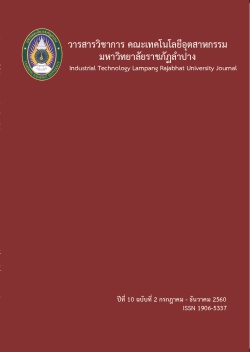การศึกษาอัตราส่วนของดินบ้านหัวฝายกับดินเชื้อ ที่เหมาะกับการขึ้นรูปผลิตภัณฑ์เครื่องปั้นดินเผา
Keywords:
ดินเชื้อ, ดินบ้านหัวฝาย, การขึ้นรูป, Clay, Huephai Clay, FormingAbstract
การวิจัยครั้งนี้เป็นการวิจัยเชิงทดลอง โดยมีวัตถุประสงค์ 1) เพื่อศึกษาเนื้อดินบ้านหัวฝายตำบลบ้านจาน อำเภอพุทไธสง จังหวัดบุรีรัมย์ 2) เพื่อพัฒนาสมบัติของเนื้อดินให้เหมาะสมในการขึ้นรูปผลิตภัณฑ์เครื่องปั้นดินเผา โดยศึกษาอัตราส่วนผสมระหว่างดินบ้านหัวฝายกับดินเชื้อ จำนวน 10 สูตร เผาที่อุณหภูมิ 800 เซลเซียส และที่อุณหภูมิ 1100 องศาเซลเซียส จากการทดลองพบว่าที่อุณหภูมิ 1100 องศาเซลเซียส อัตราส่วนผสมของเนื้อดินที่เหมาะสำหรับการขึ้นรูปผลิตภัณฑ์เครื่องปั้นดินเผา คือ สูตรที่ 4 ซึ่งมีอัตราส่วนผสมของดินพื้นบ้านหัวฝาย ร้อยละ 80 และดินเชื้อ ร้อยละ 20 เนื้อดินหลังการเผาให้สีน้ำตาลอ่อนจนถึงสีน้ำตาลเข้มมีอัตราการหดตัวของเนื้อดินอยู่ที่ร้อยละ 14.10 มีค่าการดูดซึมน้ำร้อยละ 11.80 และมีค่าความแกร่งของเนื้อดินอยู่ที่ 172.90 กิโลกรัมต่อตารางเซนติเมตร เมื่อนำมาทดสอบขึ้นรูปในแบบอิสระ พบว่าเนื้อดินสามารถขึ้นรูปได้ดี เนื้อดินมีความเหนียวดี สามารถกดหรือรีดดินให้เป็นแผ่น และคลึงให้เป็นเส้นมีความสม่ำเสมอ ในส่วนการขึ้นรูปด้วยแป้นหมุนพบว่าเนื้อดินตั้งศูนย์ได้ง่าย ทรงตัวได้ดี จัดรูปทรงได้ง่าย สามารถขึ้นรูปเป็นชิ้นงานได้หลายขนาด ซึ่งสามารถนำไปใช้ในการผลิตเครื่องปั้นดินเผา ในเชิงอุตสาหกรรมขนาดเล็กได้
A Study of The Ratio of Huepai Village Clay with Grog for Pottery Product forming
This aims of this research paper are: 1) To study properties of the clay from Huephai village, Bhuthaisong district, in the province of Buriram. 2) To study and improve the quality of the clay to be the most suitable for molding and creating pottery products. The is done by taking a 10 samples of varying clay and soil mixtures and heating them at temperatures of between 800 degrees Celsius and 1,100 degrees Celsius. At 1100°C Celsius, it was found that the 4th formula was the most appropriate formula which contained 80% of Huepai clay and 20% of regular clay. The mixture turned from light brown to dark brown after firing. The physical properties of the object were as follows: 14.10% shrinkage, 11.80% water absorption, and 172.90 kg/cm2 strength which proved that this particular mixture of clay could be classified as Terracotta. This successful 4th formula of mixed clay could be formed by both hand-modeling and throwing techniques. The clay mixture was smooth and soft. It could be rolled easily into sheets or flat plates with a uniform thickness which was advantageous for forming. While using the throwing technique, the clay was well poised and easily formed into any shape and dimension. In conclusion, the 4th formula of mixed clay could possibly be used in industrial manufacturing.






